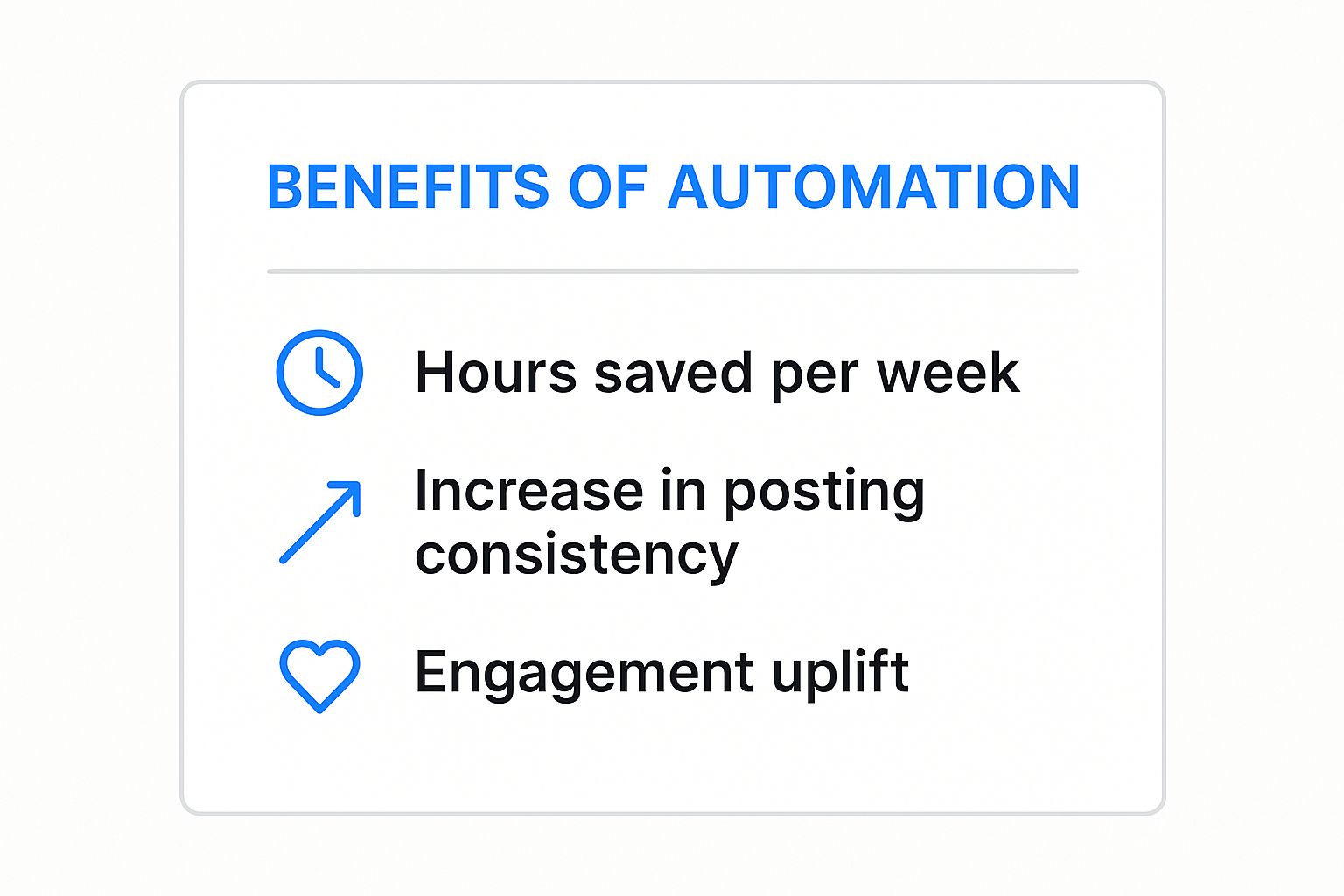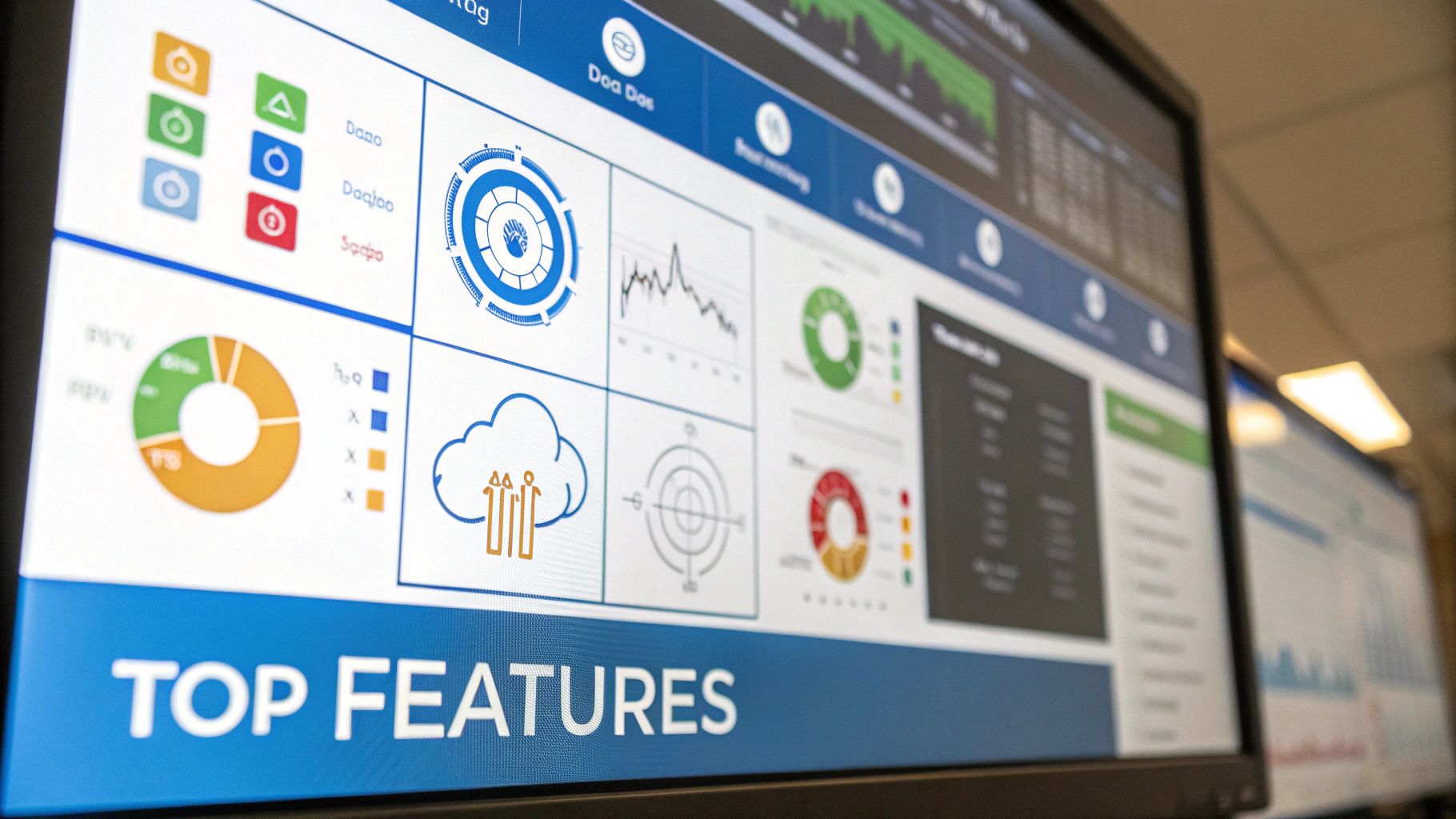Why Automatic Social Media Posting Is Your Secret Weapon
Maintaining a consistent social media presence can be a demanding task. It requires significant time and effort, often feeling like a full-time job in itself. This is where automatic social media posting offers a valuable solution, streamlining workflows and expanding your reach. Discussions with marketing directors already using automation reveal its positive impact on their overall strategy.
Reclaiming Your Time and Boosting Morale
One of the biggest advantages of automated posting is the time saved. Consider the hours typically spent drafting posts, sourcing images, and managing multiple accounts. Automation frees up this valuable time, allowing you to focus on more strategic activities like content planning and community engagement. This not only increases productivity but also has a positive effect on team morale. Freeing team members from repetitive tasks empowers them to focus on more creative and engaging work.
Balancing Efficiency With Authenticity: Addressing the "Robot" Fear
Many worry that automation will make their social media presence feel impersonal. This is a legitimate concern, but it's easily addressed by striking the right balance between efficiency and authenticity. Many businesses use automation for scheduled evergreen content and promotional updates. This allows more time for genuine interactions in comments and direct messages. You can maintain a consistent posting schedule while still retaining the personal touch that builds real connections. Over the last decade, the use of social media management tools like Sprout Social and Hootsuite has increased significantly. These platforms enable scheduled posting across various social media channels. Sprout Social even offers AI-powered features for message prioritization and sentiment analysis, helping to streamline customer engagement. Learn more about AI-powered tools. This trend clearly demonstrates the growing recognition of automation's value in successful social media management.
Choosing the Right Content for Automation
It's important to remember that not all content is suitable for automation. Some content thrives on scheduling, while other types require a more personal approach. Product updates, blog post promotions, and evergreen content like industry tips or inspirational quotes are excellent choices for automated posting. However, responding to comments, participating in discussions, and handling customer service inquiries should always be done by a human. Automating these interactions could negatively impact your community relationships. Finding the right balance is essential for leveraging the power of automation while maintaining authenticity. Knowing what works best for each aspect of your social media strategy is vital for maximizing engagement and reaching your objectives. Using automatic posting strategically for appropriate content frees up your time to cultivate meaningful connections with your audience.

The Ultimate Toolkit for Automatic Social Media Posting
Choosing the right tools for automatic social media posting can significantly improve your social media strategy. It's more than just scheduling posts randomly; it requires a strategic approach to leverage automation effectively. The infographic below illustrates key automation benefits, highlighting time saved, posting consistency, and increased engagement.

As the infographic shows, automation can save marketers hours each week, resulting in a more consistent posting schedule and subsequently, higher engagement. Consistent posting is vital for building a strong social media presence. Furthermore, automating your social media posting can considerably boost your strategy. For tips on repurposing existing content, check out this guide on how to repurpose blog content for social media.
Key Features to Look For in Automation Tools
Several important features distinguish effective automatic social media posting tools. A good platform should offer multi-account management, allowing you to manage multiple social media profiles from one dashboard. This streamlines your workflow and eliminates constant app switching.
Format optimization is another essential feature. Each social media platform has specific requirements for text length, image dimensions, and hashtag usage. A robust automation tool automatically optimizes your content to fit these varying requirements, ensuring professional, polished posts across all networks without manual adjustments. Platforms like PostOnce offer seamless integration with newer networks like Threads and BlueSky, alongside established platforms like Facebook, Instagram, Twitter and Reddit.
Choosing the Right Tool for Your Needs
The best tool depends on your specific needs. A simpler, more affordable option might suffice for solo creators. However, for managing enterprise accounts, look for advanced features like content recycling, approval workflows, and cross-platform analytics.
For teams, the learning curve is a critical factor. Choose an intuitive platform that's easy for all team members to use. Some platforms cater to larger teams with collaboration and content approval features, while others are better for individual users. For more detailed insights into different techniques, see our guide on How to master social media scheduling. Ultimately, the right tool empowers you to achieve your specific social media goals.
To help you make an informed decision, we've compiled a comparison of some popular tools:
The following table provides a comparison of popular social media management platforms:
Comparison of Top Automatic Social Media Posting Tools
A comprehensive comparison of the leading social media automation platforms based on key features, pricing, and ideal business size
| Tool Name | Key Features | Pricing | Best For | Platform Support |
|---|---|---|---|---|
| Buffer | Post scheduling, analytics, engagement tools | Free plan available, paid plans from $6/month | Small to medium businesses, individuals | Facebook, Instagram, Twitter, LinkedIn, Pinterest |
| Hootsuite | Multi-account management, content curation, team collaboration | Free plan available, paid plans from $99/month | Medium to large businesses, agencies | Facebook, Instagram, Twitter, LinkedIn, YouTube, Pinterest |
| SproutSocial | Social listening, analytics, reporting, CRM integrations | Paid plans from $249/month | Large businesses, agencies | Facebook, Instagram, Twitter, LinkedIn, Pinterest, YouTube |
| Later | Visual content scheduling, hashtag research, Instagram analytics | Free plan available, paid plans from $18/month | Businesses focused on visual content, Instagram marketers | Instagram, Pinterest, TikTok, Twitter, Facebook |
| MeetEdgar | Content recycling, automated posting queues | Paid plans from $49/month | Businesses with a large content library, bloggers | Facebook, Instagram, Twitter, LinkedIn, Pinterest |
This table highlights key differences in features and pricing, allowing you to quickly identify which tool best aligns with your budget and requirements. Choosing the appropriate tool is essential for maximizing efficiency and achieving your social media objectives.
Crafting Your Automatic Posting Strategy That Actually Works
Automating your social media presence goes beyond simply scheduling posts. It's about strategically automating your content for maximum impact. This requires understanding what type of content thrives on automation and how to maintain a consistent brand voice, even when posts are scheduled. Think of it as a well-oiled machine: you set it up, and it runs smoothly, allowing you to focus on more strategic tasks.
Data-Driven Content Audits: Knowing What to Automate
Before automating anything, conduct a content audit. Analyze past performance data to identify your top-performing content. This data-driven approach reveals what resonates with your audience and is worth the automation investment. For example, evergreen content, like industry tips or blog post promotions, consistently performs well and is ideal for scheduling. This maintains a steady flow of valuable content without constant manual input.
Building a Dynamic Content Calendar
Once you know what to automate, build a dynamic content calendar. This isn't a rigid structure, but a flexible framework aligning with your business goals. Include a mix of automated evergreen content and space for timely, reactive posts. This balance ensures consistent posting while allowing you to leverage trending topics or engage with current events. You might be interested in: How to master a posting strategy.
Identifying Your Optimal Posting Cadence
Finding the optimal posting frequency, or cadence, is critical. Over-posting can overwhelm your audience, while under-posting can make you appear inactive. Experiment to find the sweet spot for each platform. Stagger your posts to reach different audience segments throughout the day. This maximizes visibility without being intrusive. To find the right tools for your strategy, explore a range of social media automation tools. Social media advertising spend is projected to reach $276.7 billion by 2025, highlighting the growing importance of social media in business. Find more detailed statistics here.

Maintaining Brand Voice and Quality Control
Maintaining a consistent brand voice across automated content is essential. Create clear brand guidelines for your team. This ensures all scheduled posts, even those created by different team members, maintain the same tone and style. Implement an approval process for quality control before posting. This final check catches errors and reinforces your brand image, building trust and recognition with your audience.
Balancing Automation With Genuine Human Connection
Automating social media posts offers powerful tools for businesses looking to expand their reach. However, this presents a challenge: how can you maintain authentic connections while scaling your online presence? The solution lies in striking the right balance between automation and genuine human interaction. Think of it like a well-run restaurant: automation handles repetitive tasks like order taking and payment processing, freeing up staff to provide exceptional customer service.
Identifying Interactions That Demand Personal Attention
Not every interaction on social media should be automated. Automated tools excel at scheduling content and generating basic reports. However, certain engagements require a personal touch. Responding to complex customer service inquiries or participating in nuanced discussions, for example, necessitates human interaction. Automating these can damage your brand’s reputation and erode audience trust.
Monitoring Systems for Real-Time Engagement
You can implement monitoring systems to flag crucial engagement opportunities that need prompt human responses. These systems can analyze comments and messages, identifying negative sentiment or urgent requests requiring immediate attention. This allows your team to prioritize genuine engagement where it truly matters. For further insights, check out our article on how to master engagement optimization.
Real-World Examples: Blending Scheduled Content and Community Management
Many successful brands effectively blend scheduled content with real-time community management. They use automation for routine updates, such as sharing blog posts or promotional announcements. This frees up their social media teams to focus on engaging with followers, answering questions, and building relationships. It’s important to avoid appearing overly automated. Transparency is key: acknowledge when a response is automated and offer to connect with a human representative if needed.
Maintaining a Consistent Voice Across Multiple Team Members
Maintaining a consistent brand voice across multiple team members can be a challenge, especially when using automated posts. Developing clear brand guidelines and a style guide helps ensure everyone uses the same tone and language. This creates a unified brand experience, regardless of who interacts with your audience. Regular team training and shared best practices further contribute to consistent communication across platforms. This approach enhances brand recognition and fosters a sense of community among your followers. For larger teams, automation tools with features like saved replies and comment templates can help improve consistency.
Advanced Optimization Techniques Leading Brands Don't Share

Successfully automating your social media presence goes beyond simply scheduling posts. It requires adopting advanced optimization techniques often used by seasoned digital marketers. This means constantly refining your automated content strategy using data analysis.
For instance, regularly analyzing post performance and adjusting your scheduling can significantly optimize your reach. This iterative process ensures your content remains engaging and delivers real results.
A/B Testing For Scheduled Content
A/B testing offers a powerful method for optimizing scheduled social media posts. This involves creating different versions of your content, experimenting with headlines, visuals, or even the entire post itself. By scheduling these variations, you can identify which version resonates best with your audience.
This process reveals patterns in engagement across different formats, posting times, and messaging styles. Ultimately, A/B testing empowers you to understand what truly connects with your audience and refine your strategy accordingly.
Leveraging Platform-Specific Analytics
Understanding the nuances of each social media platform is essential. Each platform provides unique insights into audience behavior and content performance. By carefully studying these platform-specific analytics, you can tailor your automation rules based on the most relevant indicators.
For example, Instagram insights might prioritize reach and impressions, while LinkedIn may emphasize click-through rates. Utilizing platform-specific analytics is crucial for effective automated posting.
Strategic Content Recycling and Adaptation
Strategic content recycling offers a smart way to extend the life of your most successful content. This involves repurposing existing high-performing content into new formats or adapting it for different platforms.
A popular blog post, for example, can be transformed into a series of tweets, an infographic, or a short video. This approach maximizes the value of your existing content and saves valuable content creation time.
However, recycling content requires careful planning to avoid audience fatigue. Varying the format, messaging, and timing of recycled content is crucial. Dynamically adapting scheduled content to align with trending topics can also be effective, but it must be done thoughtfully to avoid appearing opportunistic.
Optimizing Your Automatic Posting Strategy
The success of automatic social media posting hinges on continuous optimization based on performance data. Tracking key performance indicators (KPIs) is vital for understanding what's working and what needs adjustment.
To help you understand this better, let's explore some essential performance metrics. The following table outlines key metrics to track when evaluating the success of your automated social media strategy.
Social Media Automation Performance Metrics
Essential metrics to track when evaluating the success of your automatic social media posting strategy
| Metric | Description | Target Benchmark | How to Improve |
|---|---|---|---|
| Engagement Rate | Measures likes, comments, shares, and saves. | Varies by platform and industry. | Use compelling visuals and engaging captions. Ask questions to encourage interaction. |
| Reach | The number of unique users who saw your content. | Aim for steady growth over time. | Optimize content for platform algorithms and target specific audience segments. |
| Click-Through Rate (CTR) | Percentage of users who clicked a link in your post. | Varies depending on the call to action. | Use clear and concise calls to action. Ensure links are relevant and valuable. |
| Conversions | Measures actions taken by users after clicking a link (e.g., purchases, sign-ups). | Aligned with your overall business objectives. | Track conversion pixels and optimize landing pages. |
By consistently monitoring and analyzing these metrics, you can fine-tune your automatic social media posting strategy for optimal performance. This ensures your automated content remains relevant and contributes to your overall business goals.
Tools like PostOnce can help you seamlessly manage and analyze these metrics across various platforms. Remember, optimization is a continuous journey, and remaining adaptable is the key to unlocking the full potential of automatic social media posting.
Avoiding the Automatic Posting Disasters That Cost Brands
Automatic social media posting is a powerful tool for any business looking to maintain a consistent online presence. However, even the most well-planned automation strategies can sometimes go wrong. Understanding the potential pitfalls and putting safeguards in place is essential for protecting your brand's image. This means learning from the mistakes of others and developing proactive strategies to avoid common automation problems.
Learning From Real-World Automation Failures
Many marketing teams have experienced the negative consequences of scheduling mishaps, especially during sensitive events. Imagine a cheerful promotional post automatically appearing amidst a national crisis. Such incidents demonstrate the need for real-time monitoring and quick intervention strategies. One company, for example, mistakenly scheduled a celebratory post during a period of national mourning, highlighting the need for sensitivity and responsiveness in automated posting. These kinds of errors underscore the importance of a clear strategy and careful planning.
Approval Workflows and Emergency Override Protocols
To prevent these public relations disasters, establish approval workflows for all scheduled content. This adds an extra layer of review, catching potentially insensitive posts before they are published. In addition, establish emergency override protocols to quickly pause or delete scheduled content in unexpected circumstances. This rapid response capability minimizes any potential damage and shows your audience that you're attentive. This can be as simple as having a designated team member with the authority to halt all scheduled posts or using a "kill switch" feature within your social media management platform.
Technical Pitfalls and Troubleshooting
Beyond content mishaps, technical issues can also disrupt your automated social media strategy. Broken links in scheduled posts lead to user frustration and diminished marketing effectiveness. Image rendering inconsistencies across various platforms can project an unprofessional image. Furthermore, sudden API changes can disrupt carefully constructed automation rules. For instance, a change in a platform's API could cause scheduled images to disappear or text to be cut short.
Practical Troubleshooting Solutions
Fortunately, simple troubleshooting steps can resolve many technical difficulties. Regularly verify links in your scheduled posts using a link checker. Preview your content on every intended platform to catch image rendering issues. Keep up-to-date on API changes by subscribing to developer updates from the social media platforms you use. This proactive approach avoids unpleasant surprises and ensures your automated posts appear correctly. Having a backup plan, such as manually posting content if a technical problem occurs, maintains consistency.
For a streamlined process, consider a platform like PostOnce that handles smart cross-posting and format optimization, minimizing many technical hurdles. PostOnce adapts your content to the specific requirements of each platform, ensuring a polished and professional look without constant manual intervention. Streamline your social media posting and steer clear of automation pitfalls by exploring PostOnce.